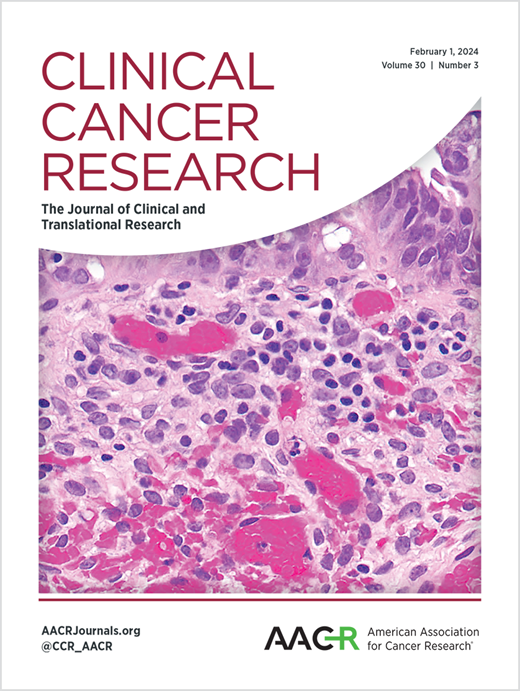Durvalumab与医生选择化疗治疗复发性卵巢透明细胞腺癌(MOCCA/APGOT-OV2/ gggs - ov3):一项多中心、随机、2期试验
IF 10.2
1区 医学
Q1 ONCOLOGY
引用次数: 0
摘要
目的卵巢透明细胞癌复发的最佳治疗方法尚不明确。这是首个比较durvalumab与化疗在rOCCC中的随机试验。smocca是一项在新加坡、韩国和澳大利亚进行的随机2期临床试验。符合条件的患者为经铂类化疗后复发的rOCCC, ECOG表现状态≤2,既往无免疫检查点阻断。患者随机分配(2:1)至durvalumab组(每4周1500mg)或化疗组。化疗进展的患者被允许交叉使用杜伐单抗。主要终点为无进展生存期(PFS)。次要结局包括总生存期(OS)、客观缓解率(ORR)和安全性。48名符合条件的女性被分配到durvalumab (N= 31)或化疗(N= 17)。杜伐单抗或化疗的中位PFS分别为7.6周(95% CI 7.0-16.0)和14.0周(95% CI 7.0-32.9), (HR 1.6, 95% CI 0.8-3.0;P = 0.92)。中位OS分别为37.9周(95% CI 21.7-143.0)和40.6周(95% CI 25.0-未达到)(HR 1.5, 95% CI 0.7-3.3;P = 0.85)。两组间ORR差异无统计学意义(durvalumab 9.7% vs PCC 18.8%;差异-9.1%,95% CI -31.3%-12.9%;P = 0.83)。durvalumab的全级别(35.5% vs 68.8%)和高级别(9.7% vs 31.3%)治疗相关不良事件较少。28.9% (CPS≥1%)和10.5% (CPS≥10%)的患者出现PD-L1 CPS+。PIK3CA突变与durvalumab治疗进展时间相关(12周)(RR(突变型vs -野生型)2.83,95% CI 1.16至14.17)。结论sdurvalumab耐受性良好,但与化疗相比,不能改善rOCCC患者的疗效。本文章由计算机程序翻译,如有差异,请以英文原文为准。
Durvalumab versus physician's choice chemotherapy in recurrent ovarian clear cell adenocarcinoma (MOCCA/APGOT-OV2/GCGS-OV3): a multicenter, randomized, phase 2 trial.
PURPOSE
The optimal treatment of recurrent ovarian clear cell carcinoma (rOCCC) remains unknown. This is the first randomized trial to compare durvalumab with chemotherapy in rOCCC.
PATIENTS AND METHODS
MOCCA is a randomized, phase 2 trial conducted in Singapore, Korea and Australia. Eligible patients had rOCCC with recurrence after platinum-based chemotherapy, ECOG performance status ≤2 and no prior immune checkpoint blockade. Patients were randomly assigned (2:1) to durvalumab (1500mg every 4 weeks) or chemotherapy. Patients progressing on chemotherapy were allowed to crossover to durvalumab. The primary outcome was progression-free survival (PFS). Secondary outcomes included overall survival (OS), objective response rates (ORR), and safety.
RESULTS
48 eligible women were assigned to durvalumab (N= 31) or chemotherapy (N= 17). Median PFS was 7.6 (95% CI 7.0-16.0) and 14.0 (95% CI 7.0-32.9) weeks with durvalumab or chemotherapy, (HR 1.6, 95% CI 0.8-3.0; P= 0.92). Median OS was 37.9 (95% CI 21.7-143.0) and 40.6 (95% CI 25.0-not reached) weeks, respectively (HR 1.5, 95% CI 0.7-3.3; P= 0.85). The difference in ORR between groups was not statistically significant (durvalumab 9.7% vs PCC 18.8%; difference -9.1%, 95% CI -31.3%-12.9%; P= 0.83). Fewer all-grade (35.5% vs 68.8%) and high-grade (9.7% vs 31.3%) treatment-related adverse events were observed for durvalumab. PD-L1 CPS+ was observed in 28.9% (CPS≥1%) and 10.5% (CPS≥10%) of patients. PIK3CA mutations were associated with time to progression on durvalumab ³12 weeks (RR(-mutated vs -wildtype) 2.83, 95% CI 1.16 to 14.17).
CONCLUSIONS
Durvalumab was well-tolerated, but did not improve efficacy outcomes compared with chemotherapy in rOCCC.
求助全文
通过发布文献求助,成功后即可免费获取论文全文。
去求助
来源期刊

Clinical Cancer Research
医学-肿瘤学
CiteScore
20.10
自引率
1.70%
发文量
1207
审稿时长
2.1 months
期刊介绍:
Clinical Cancer Research is a journal focusing on groundbreaking research in cancer, specifically in the areas where the laboratory and the clinic intersect. Our primary interest lies in clinical trials that investigate novel treatments, accompanied by research on pharmacology, molecular alterations, and biomarkers that can predict response or resistance to these treatments. Furthermore, we prioritize laboratory and animal studies that explore new drugs and targeted agents with the potential to advance to clinical trials. We also encourage research on targetable mechanisms of cancer development, progression, and metastasis.
 求助内容:
求助内容: 应助结果提醒方式:
应助结果提醒方式:


